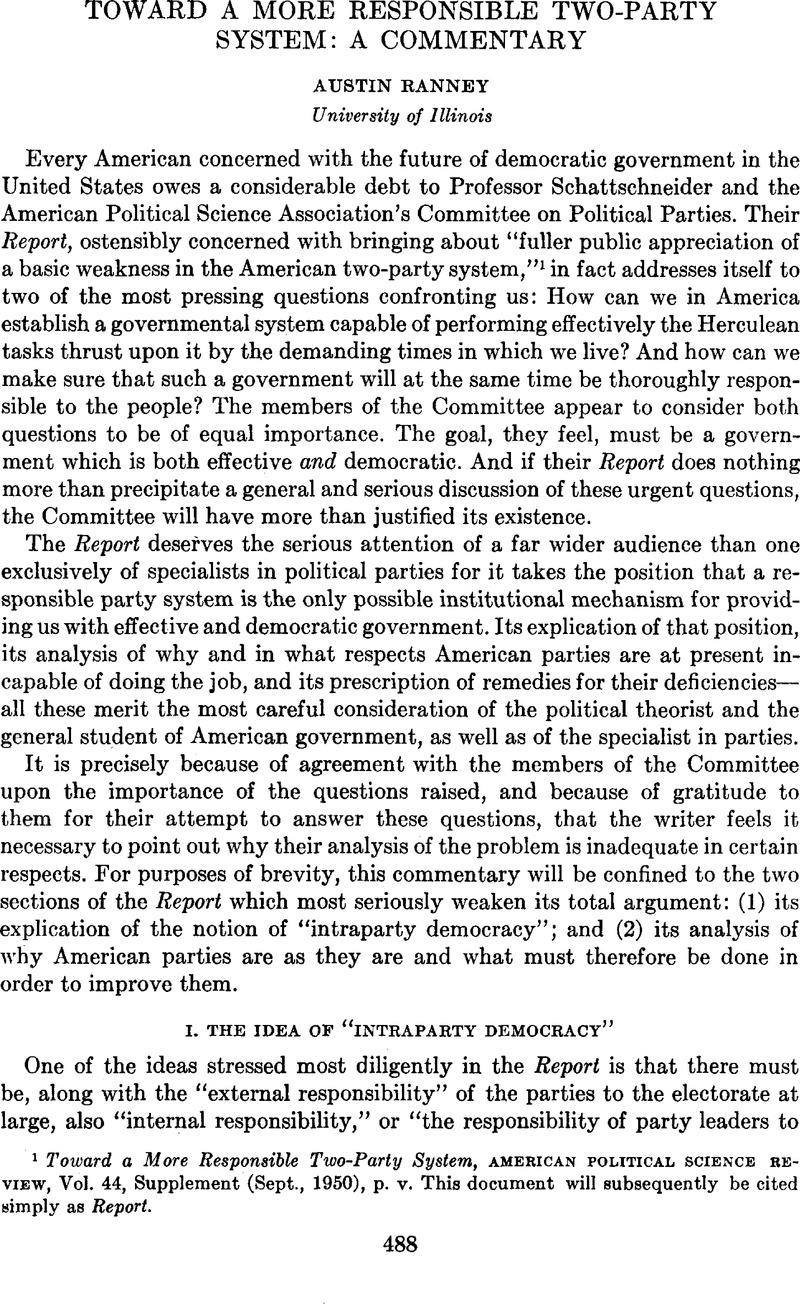Article contents
Toward a More Responsible Two-Party System: A Commentary
Published online by Cambridge University Press: 02 September 2013
Abstract

- Type
- Notes and Memoranda
- Information
- Copyright
- Copyright © American Political Science Association 1951
References
1 Toward a More Responsible Two-Party System, American Political Science Review, Vol. 44, Supplement (Sept., 1950), p. vGoogle Scholar. This document will subsequently be cited simply as Report.
2 Ibid., p. 23.
3 Idem.
4 Ibid., p. 27 (emphasis in the original).
5 Ibid., pp. 70–72. It is difficult to see the relevance of these proposed reforms to either “internal” or “external” responsibility. Is there any evidence to suggest, for example, that Senator Knowland (from a cross-filing State) and Senator Magnuson (from a blanket-primary State) disagree with and stray from the programs and positions of their respective parties more than, say, Senator Morse, Senator Tobey, or ex-Senator Elmer Thomas (all from closed-primary States)?
6 Ibid., p. 69.
7 Ibid., pp. 66–70.
8 Ibid., pp. 28–29.
9 Party Government (New York, 1942), pp. 53–57Google Scholar.
10 Cf. Michels, Robert, Political Parties: A Sociological Study of the Oligarchical Tendencies of Modern Democracy (Eden, and Paul, Cedar trans.; London, 1915) passimGoogle Scholar.
11 Report, pp. 67–68.
12 Cf. Schattschneider, op. cit., pp. 56–58.
13 Cf. Report, p. 15.
14 Op. cit., p. 58.
15 Ibid., p. 60 (emphasis in the original).
16 Cf. ibid., pp. 7–10, 123–128; Key, V. O., Politics, Parties and Pressure Groups (2nd ed.; New York, 1947), pp. 664–667Google Scholar; Odegard, P. H. and Helms, E. A., American Politics (2nd ed.; New York, 1947), pp. 124–131Google Scholar; and McKean, D. D., Party and Pressure Politics (Boston, 1949), pp. 29–49Google Scholar.
17 Report, p. 26.
18 Ibid., pp. 26–31.
19 Ibid., pp. 35–36 (emphasis added).
20 Op. cit., pp. 209–210.
21 Report, p. v.
22 The three exceptions are: revising the operation of the Electoral College so that the percentage of electoral votes a candidate receives will reflect his share of the popular vote (p. 74); lengthening the term of members of the House of Representatives to four years (p. 75); and introducing the short ballot principle into state elections (p. 77).
23 Ibid., p. 25 (emphasis in the original).
24 “The Influence of Party upon Legislation in England and America,” Annual Report of the American Historical Association for the Year 1901 (Washington, D. C., 1902), Vol. 1, pp. 321–542Google Scholar.
25 Cf., for example, the present writer's discussion of “Goodnow's Theory of Politics,” Southwestern Social Science Quarterly, Vol. 30, pp. 268–276 (March, 1950)Google Scholar.
26 Note, in illustration of this point, the fact that Wilson's Congressional Government, which was first published in 1885 and was a strong defense of the doctrine of responsible party government as applied to the American party system, went through twenty-five impressions, the last of which appeared in 1925. And even as President, Wilson continued to argue for more responsible parties.
27 Essays on Government (Boston, 1897)Google Scholar, particularly in the essays entitled “Cabinet Responsibility and the Constitution” and “Democracy and the Constitution.”
28 Ibid., pp. 21–22.
29 Ibid., p. 22.
30 Ibid., pp. 90–104.
31 Report, p. 36.
32 Lowell, , Essays on Government, pp. 107–108Google Scholar (emphasis added).
33 Public Opinion and Popular Government (New York, 1913), pp. 65–66, 96–97, 105, 139–140Google Scholar.
34 For an able recent statement, by one of its leading American exponents, of what is involved in the majoritarian position, see Kendall, Willmoore, “Prolegomena to Any Future Work on Majority Rule,” Journal of Politics, Vol. 12, pp. 694–713 (Nov., 1950)CrossRefGoogle Scholar.
35 This, of course, is difficult of final proof. The writer has derived his strong impression that this statement is valid from discussions of the issues with students, his understanding of the present academic and popular literature on the nature of democracy, and his interpretation of the significance of the general American belief in the desirability of such an institution as judicial review. Whether or not this statement is accurate, however, it is at least clear that Americans are not generally committed to a belief in the desirability of “unlimited” majority rule. And that, for the purposes of the argument that follows in the text, is the important point.
36 Cf. Report, pp. 52–53, 61.
37 Ibid., pp. 20–22.
- 16
- Cited by





Comments
No Comments have been published for this article.